Joseph-Armand Bombardier
Ingenuity is in our DNA
Joseph-Armand Bombardier’s ingenuity and individual excellence were born of a true collective strength that, over the years, led to the creation of the Bombardier and BRP companies, now global icons of the transport industry.
The Museum of Ingenuity J. Armand Bombardier showcases the legacy that this famous inventor left for his successors through the innovations, trades and professions, and flagship products offered today by Bombardier and BRP.
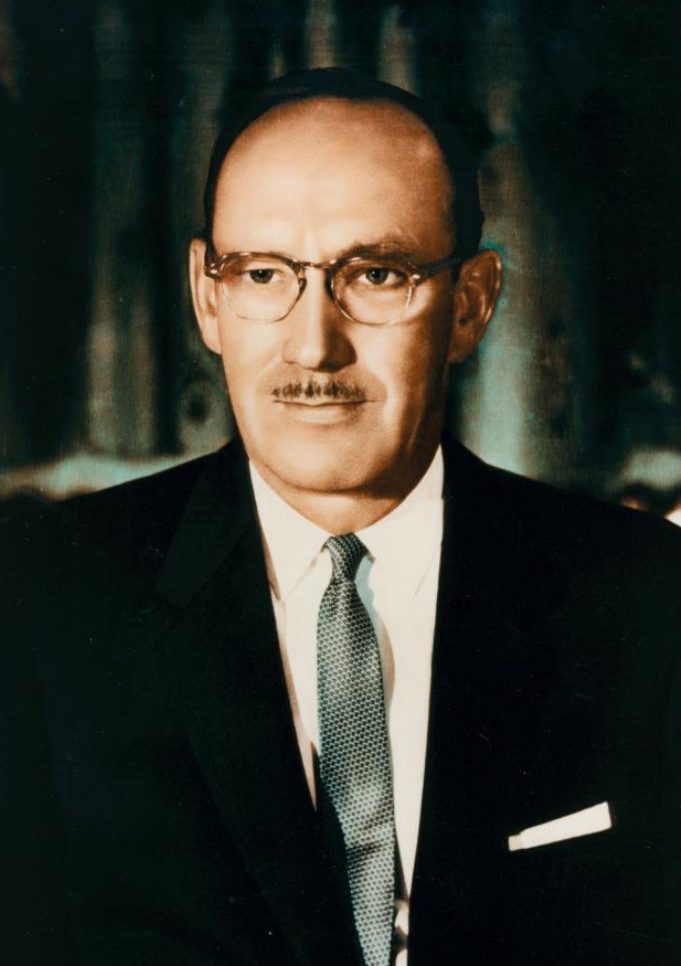
Biography
- 1907-1925: Childhood and adolescence
-
Joseph-Armand Bombardier was born on April 16, 1907, in Valcourt, in the Eastern Townships of Quebec, Canada. No one in this peaceful farming village could have foreseen the exceptional destiny that lay ahead for the newborn.

Miniature locomotive, 1920
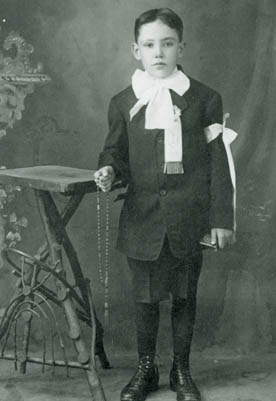
Joseph-Armand Bombardier, the day of his First Communion, 1916
Mechanical toys
As a boy, Joseph-Armand shows remarkable curiosity for everything mechanical, disassembling and reassembling a variety of mechanisms. At a mere 13 years old, he manufactures one of his first mechanical toys a miniature locomotive driven by a clock mechanism and paints the object in great detail, showing his advanced sense of both the mechanical and aesthetic. Other mobile toys, such as tractors and boats, soon result from Joseph-Armand’s fertile imagination, to the immense pleasure of his brothers, sisters, and friends.
The entrepreneurial spirit that will eventually lead this inventor to success is already present: to finance the purchase of his clock mechanisms from the village jeweller, the young Joseph-Armand uses the money he earns serving mass to the parish.
From spinning wheel to cannon
Everything is possible in Joseph-Armand’s feverishly inventive mind. He builds a steam engine out of old sewing machine parts. With permission from his aunt Marie, he mounts the engine on her spinning wheel, and to the boy’s great joy and his aunt’s distress the experiment works: the wheel spins faster and faster.
Joseph-Armand’s curiosity is constant. He convinces the local veterinarian, Mr. Archambault, the father of his friend Paul, to give him a broken 12-calibre gun. Joseph-Armand happily goes to work shortening the barrel, modifying the firing system, cutting and polishing the butt, and changing the breech. Then he mounts the new device on metal wheels, and demonstrates his mini-cannon at Paul’s house a week later. The gun is detonated with black powders in the presence of a dumbfounded veterinarian.
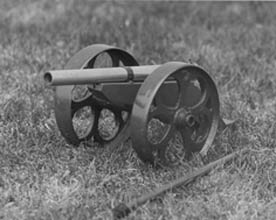
Miniature cannon, 1921
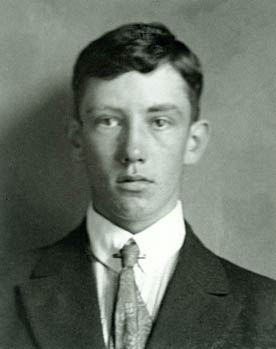
Joseph-Armand Bombardier at ages 14, 1921
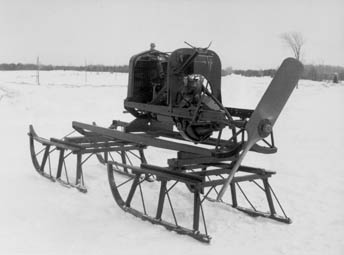
1922 Vehicle
The infernal engine
Joseph-Armand takes great pleasure in dismantling and reassembling Alfred Bombardier’s car motor, so to keep him away from it, Alfred gives his son an old Model T Ford motor considered “irreparable.” With the help of his brother Léopold, the adolescent nevertheless fixes it and soon incorporates it into a vehicle of his own design.
His first snow machine must wait a few months, however, because Alfred sends him to pursue studies at Sherbrooke’s Séminaire Saint-Charles-Borromée near Valcourt at the age of 14. Alfred hopes that his eldest son will join the priesthood, following a firmly rooted tradition of Quebec francophone families.
Insurmountable obstacles become challenges in the mind of Joseph-Armand. Away from his workshop, the schoolboy continues developing his latest idea. Upon his return for Christmas and New Year’s vacation, he retreats to his father’s workshop where he prepares a surprise with his brother Léopold and a few cousins.
New Year’s Eve day Alfred Bombardier watches in astonishment as a strange sled propelled by the old Ford motor emerges from his workshop a veritable “infernal engine.” Sitting in front, Léopold steers the machine using cotton rope reins, while Joseph-Armand, standing at the back, operates the motor, which drives a propeller manufactured by the young inventor himself.
At 15 years old, the inventor has created his first snow vehicle. Its launch surprises and amazes everyone, but Alfred Bombardier quickly orders it dismantled, concerned about the dangerous propeller. Joseph-Armand obeys, but is secretly proud of having successfully driven his machine on the snow.
Change of direction
Joseph-Armand’s intellectual curiosity and ingenuity, and his pleasure in crafting different mechanisms and repairing motors, are an early sign of the passion that will drive him through life. He continues his studies at the Séminaire, but his heart isn’t in it. He knows he will be neither a priest, nor doctor, nor farmer, but rather a mechanic.
At age 17 he obtains his father’s consent to quit college and begin an apprenticeship at Gosselins’s Garage in South Stukely in the spring of 1924. He then left to work in Montreal where he took night-school courses in mechanics and electrical engineering. He also took english courses and reads all the science and technology publications he can get his hands on.
- 1926-1938 : first success
-
Joseph-Armand returns to Valcourt in 1926 to open his own garage. His father lends him money, and his family helps build the garage. He’s only 19, but his remarkable ability to solve any mechanical problem, whether dealing with cars, bench saws, or agricultural pumps, earns him an outstanding reputation throughout the region. His success allows him to pay back his father’s loan by 1929.
A concern through his youth is the isolation of Quebec villages in winter, which prevented motorized travel. Joseph-Armand takes advantage of his seasonal business to put his genius to work seeking a solution to snowbound winters.
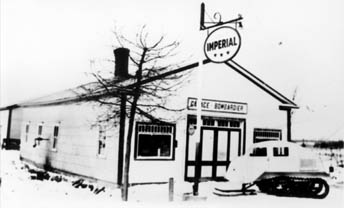
Garage Bombardier
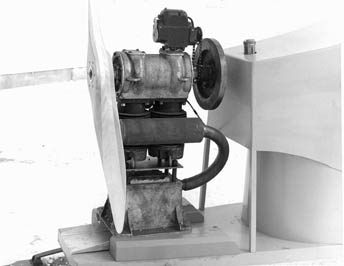
Propeller engine, 1933 Vehicle
Untiring research
The challenge is to design a motorized vehicle light enough to travel on snow, and equipped with a motor, traction, and suspension adapted to the changing consistency of snow. For 10 years Joseph-Armand toils determinedly on the project, often late at night and even on Sundays. His trials and research multiply, eating into his savings and attracting mockery from observers when partial advancements end in failure. But his intuitive and reasoned methodology leaves no room for doubt and sarcasm. Year after year, he develops a variety of prototypes by adapting automobiles.
Car motors are too heavy for the light vehicles he wants to design, so in 1933 he builds a lighter 45-kg motor fitted on new prototypes for one or two persons. But the new motor tends to overheat, and the inventor has to return to the car engines and the design of heavy vehicles.
Joseph-Armand’s son Yvon dies of peritonitis at the age of two in the winter of 1934, when the family is unable to get him to the hospital for treatment. Urged on by the pain of his loss, Joseph-Armand increases his efforts to overcome rural isolation in winter. The next year he uses a cogged gear wheel, the sprocket made of wood covered with rubber, to pull the track. The latter is comprised of two rubber bands connected by steel cross-links. This revolutionary sprocket wheel/track system is at long last the solution for snow travel.
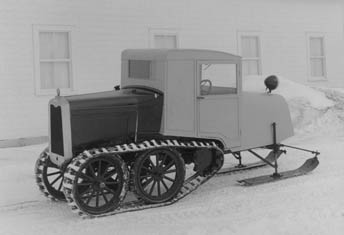
1935 Vehicle
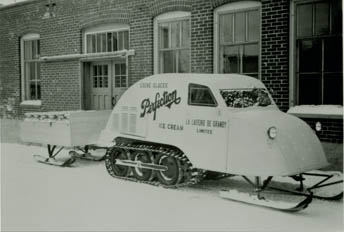
A B7 snowmobile of Perfection, ice cream company
Patent and production
The 1935 sprocket wheel/track system is Joseph-Armand Bombardier’s first major invention. Being aware of its importance and familiar with trade laws, he requests a patent from Ottawa on December 19, 1936. Six months later, on June 29, 1937, he receives a positive response from the Patent Office. Triumph! Joseph-Armand’s efforts are finally recognized, and his dreams are within grasp.
A difficult choice now awaits him: should he exploit the patent himself or sell it at a handsome profit to an automobile manufacturer? The visionary entrepreneur opts to develop his patent in Valcourt, and in so doing becomes an industrialist. The Garage Bombardier was expanded and transformed into a production plant and will now operate year round, bringing jobs and prosperity to the small town.
The first seven production snowmobiles emerge from the new factory in the winter of 1936-37. They bear name B7, B for Bombardier and 7 for the number of passengers and are well received by customers. But the inventor is always seeking to improve his products. He notices that an excessive amount of snow and ice accumulates in the vehicle’s wheel spokes. Joseph-Armand solves the problem by assembling a press that makes solid wheels, showing once again his capacity for innovation and self-sufficiency, as well as his preoccupation with quality. The first B7 snowmobiles equipped with solid wheels appear in 1940.
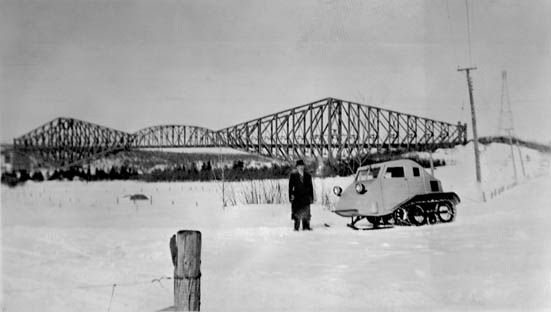
Joseph-Armand Bombardier and a B7 snowmobile, 1936
Personalized sales
Demand drives production upward over the following years, and Joseph-Armand strengthens that demand by giving vehicle demonstrations. He can be seen winding his way around the province in his B7 snowmobile, showing its potential and his keen business sense.
While touring the province, Joseph-Armand parks his B7 snowmobile near the offices of local newspapers ensuring he gets free publicity.
- 1939-1945 : the war years
-
Success of the B7 snowmobile is such that by 1939 the L’Auto-Neige Bombardier is unable to keep up with demand. A more modern plant is built in 1940 with an annual production capacity of 200 vehicles. It will be inaugurated on January 29, 1941 under the name L’Auto-Neige Bombardier.
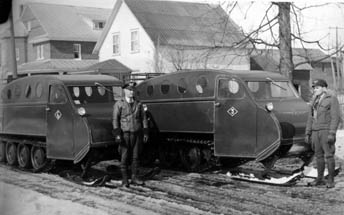
Two B12 snowmobiles

Joseph-Armand Bombardier and a B1 snowmobile
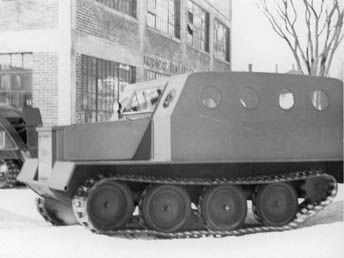
The Kaki
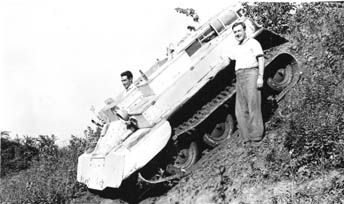
The Mark I
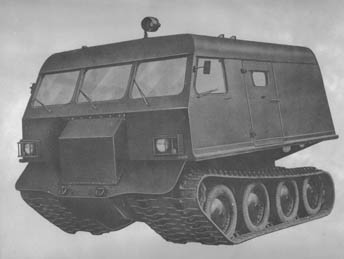
The Mark III
Birth of the B12 snowmobile
Through 1941, Joseph-Armand perfects a new snowmobile called the B12, which receives a patent on June 23, 1942. This new version of the snowmobile seats 12 passengers and features a longer, more aerodynamic profile than the B7 snowmobile.
The launch of the B12 snowmobile meets with great success, and orders increase. But momentum is short-lived, halted prematurely by Canada’s declaration of war.
Military vehicles
Material and manpower rationing now prevents Joseph-Armand from manufacturing civilian vehicles. His offer of service to the Minister of Munitions and Supply is greeted with a mandate to develop a prototype military snowmobile for transporting troops in snowbound operation zones, such as Norway.
Using the B12 snowmobile as a model, the inventor takes a few weeks to develop the prototype B1, with technical innovations submitted for Canadian and American patents. The Canadian Forces orders 130 vehicles, to be delivered in four months.
The Valcourt plant is too small for such an order, so Joseph-Armand begins production in an existing Montreal factory. He continues manufacturing parts in Valcourt to maintain employment for village workers.
At the request of Canadian authorities, Joseph-Armand develops a prototype of an armoured tracked vehicle, named Kaki, in 1943. Conclusive trials carried out near Valcourt allow the inventor to perfect the first in a series of armoured snowmobiles, named Mark I, armoured snowmobile which after modifications becomes the Mark II, also known as the Penguin. It is followed by the Mark III.
More than 1900 tracked military vehicles are produced following Joseph-Armand Bombardier’s designs between 1942 and 1946. Although wartime production is limited, civilian snowmobiles are still manufactured at a modest pace in Valcourt to meet the needs of special permit holders. Production even increases annually, going from 27 units in 1942-43 to 236 units in 1945-46.
As the war ends, Joseph-Armand Bombardier leaves Montreal to return to Valcourt where he continues expanding the company.
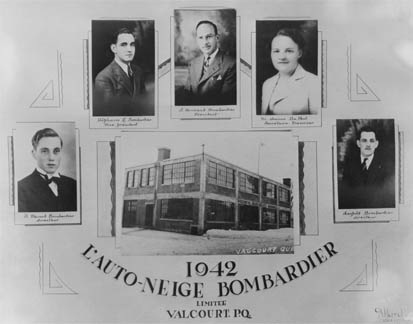
L'Auto-Neige Bombardier Limitée board of directors.
Incorporation
Despite the war and its many restrictions, Joseph-Armand tirelessly pursues his research, trials, and inventions, and continues to submit patent requests in Canada and the United States. To protect his rights and benefit close associates, he decides to give the company a legal framework. On July 10, 1942, L’Auto-Neige Bombardier Limitée is born, with a head office in Valcourt, Quebec and authorized capital of 3,000 shares.
Wartime restrictions and challenges brought out the best in Joseph-Armand Bombardier: an exceptional ability to adapt to the most limiting of circumstances, an almost limitless capacity for work, a heightened sense of responsibility toward his hometown, and a sense of open-mindedness to the changing horizons lying ahead. He possessed crucial wisdom in surrounding himself with quality people to help run his business successfully which left him more time for his inventions.
- 1946-1948 : postwar growth
-
L’Auto-Neige Bombardier Limitée experiences a boom period beginning in 1946. Demand for civilian snowmobiles returns and increases rapidly. The 1940 plant is no longer able to respond to demand, so in 1947 L’Auto-Neige Bombardier Limitée builds an assembly line plant with a capacity of 1000 vehicles, inspired by Ford factory assembly lines.
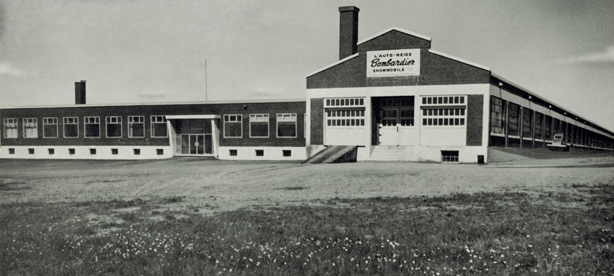
Plant of L’Auto-Neige Bombardier Limitée
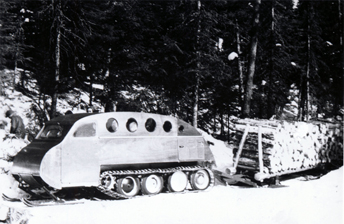
A B12 snowmobile transporting wood
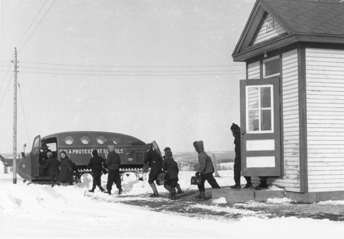
C18 snowmobile used for the transportation of schoolchildren
With the lifting of wartime restrictions, the B12 snowmobile, which had been launched just before the war, now enjoys huge popularity with a range of customers ensuring the company’s success. Between 1942 and 1951, L’Auto-Neige Bombardier Limitée produced 2,817 B12 snowmobiles.
The B12 snowmobile is highly versatile, appealing to a variety of sectors for different applications: public and materials transport, ambulance and rescue services, and transport of missionaries in isolated regions of the Canadian north. It also serves as a transport vehicle for installing and maintaining electricity and telephone lines, and on prospecting and mining sites.
Another product adds to the growth of L’Auto-Neige Bombardier Limitée after the war: the C18 snowmobile, an expanded version of the B12 model, seating 18 adults. It can also seat up to 25 school children, meeting a specific need for winter student transport. Known as the school snowmobile, it is sold as such in a number of regions in Quebec and Ontario.
In 1947-48, Joseph-Armand Bombardier’s company achieves total sales of $2.3 million, 10 times more than in 1942-43. With profits of $324 000, L’Auto-Neige Bombardier Limitée is a resounding success.
- 1949-1958 : industrial vehicles
-
The future seems certain, but 1948-1949 brings new challenges to L’Auto-Neige Bombardier Limitée. On top of a winter of very light snow, the Quebec government adopts a policy demanding all rural routes be cleared a major blow to the snowmobile market. In one year, sales fall by close to $1 million.
A disaster? Joseph-Armand Bombardier takes it as a challenge. He plans his company’s survival by ending its dependence on snowmobiles and creating new machines for new markets.
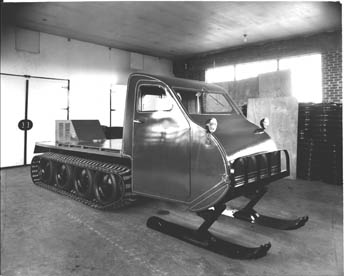
BT Industrial Vehicle
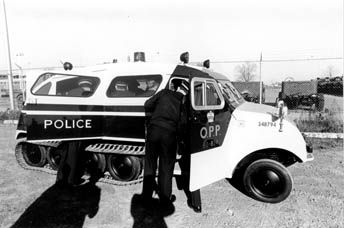
R Series Snowmobile
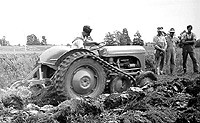
Tractor equipped with a TTA system
All-terrain vehicles
Joseph-Armand’s diversification effort begins with a period of intense and varied research for an alternative product to the snowmobile. A number of prototypes emerge from the inventor’s new experimental centre in the small town of Kingsbury near Valcourt, and are designed to tackle all sorts of terrain, from snow to swamp to peat bogs.
The BT (Bombardier Truck) industrial vehicle is a modified B12 snowmobile ready to serve the local forestry industry. New modifications, mainly based on experiments, give rise to the C4 model, the first all-track vehicle, and the B5 model, equipped with an interchangeable system of wheels and skis.
These vehicles advance the inventor’s research and lead to the later development of other commercially successful vehicles. The R Series, for example, consists of interchangeable wheels and skis in front allowing it to travel on asphalt or snow. Its sales are strong, and ensure L’Auto-Neige Bombardier Limitée success through the 1950s.
The most significant results from the rebuilding of the company’s strong position come with the launch of a new traction mechanism, the TTA (Tractor Tracking Attachment), which Joseph-Armand Bombardier perfects from his brother Gérard’s design.
The TTA improves tractor traction in muddy and swampy terrain, and thousands are sold to tractor manufacturers in North America, Europe, and South America. Patents are awarded to L’Auto-Neige Bombardier for the TTA in Canada, the United States, and the United Kingdom.
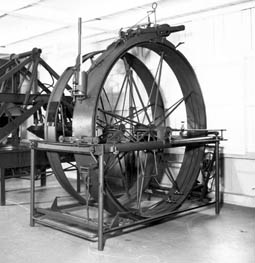
The Vulcanizing Apparatus

The Muskeg† tractor used to pose pipelines in Scotland

The Muskeg† tractor over the sands of the Sahara

The Muskeg† tractor was used during the Sir Vivian Fuchs expedition in the Antarctic
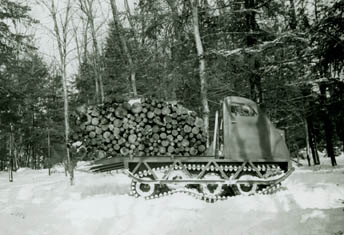
The Muskeg† Carrier HDW tractor, variety of the Muskeg† tractor, equipped with a tilting platform and a winch plays a role in mechanizing the forest industry
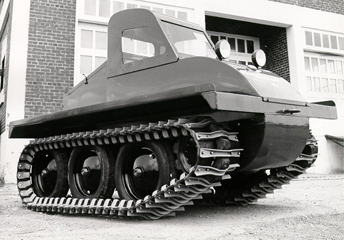
J5 tractor
New discoveries
In 1952, unsatisfactory rubber quality and market prices lead Joseph-Armand to produce rubber from raw material himself. Together with his father, eldest son Germain Bombardier founds Rockland Accessories Ltd. Established in Kingsbury, the plant opens in 1953 with the mandate to produce all the rubber parts required by L’Auto-Neige Bombardier Limitée. Rockland Accessories Ltd. became the first subsidiary of L’Auto-Neige Bombardier Limitée in 1956.
The entrepreneur is also aware of the fact that his vehicle’s track shows weakness due to the lack of resistance in the rod bolts. His track suppliers seem unable to produce the continuous track he constantly requests. For Joseph-Armand, the impossible is unacceptable: he will produce his own tracks.
His ingenuity wins out with the development of a new vulcanization process for which he received a patent that enables the production of the continuous track he requires. Joseph-Armand simultaneously succeeds in producing an all-rubber, unbreakable and shape-retaining sprocket. Thanks to these major discoveries, he can market more reliable, higher-performance vehicles.
The celebrated Muskeg† tractor
Of all vehicles produced at the Valcourt plant in the 1950s, Joseph-Armand considers the Muskeg† his greatest success of that era. The tractor’s unique quality is its low impact on the soil, which gives it enhanced accessibility to swampy areas. “Muskeg” is swamp in Amerindian.
The Muskeg† tractor is an all-track, all-terrain vehicle. Launched by the Valcourt plants in 1953, it meets with great commercial success because it fills the need to work and transport on difficult terrain, and is used as much in the Alps to carry skiers as in the Sahara to clear roads. In its modified version, the Muskeg† tractor is still sold today around the world.
In 1955, the J5 tractor the first tracked vehicle designed specifically for the forestry industry is launched and is another commercial success. Later, the vehicle is adapted by adding a shovel in front and becomes the popular sidewalk-clearing SW† still seen on the winter landscapes of towns and cities across North America.
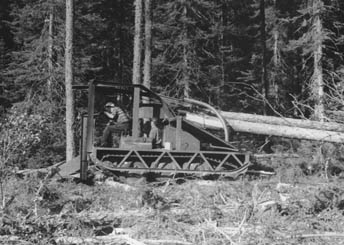
The Vit Feller Buncher
Other challenges
Joseph-Armand Bombardier is especially interested in the forest and forestry. He has already developed vehicles specifically for transporting wood, but he foresees other mechanized applications that will improve productivity. The machines he envisions can fell trees, remove their branches, cut lengths, load the logs onto the transport vehicle platform, and chip branches. Two of these machines, the VFB skidder and the BPU delimber, are launched and patented.
The Valcourt company enjoys an intense level of activity in the 1950s, thanks to its founder’s personality a happy mix of tenaciousness, ingenuity, vision, audacity, and the constant search for self-sufficiency.
- 1959-1964 : the ski-doo® snowmobile
-
At the close of the 1950s, the Valcourt company is very successful, as shown by its sales of $3.5 million and profits of $850 000 in 1958-59. The coming few years will launch Joseph-Armand Bombardier’s greatest invention, the recreational snowmobile, marketed under the name Ski-Doo®. This invention will fulfill Joseph-Armand’s boyhood dream and have a profound impact on the success and future of L’Auto-Neige Bombardier Limitée.
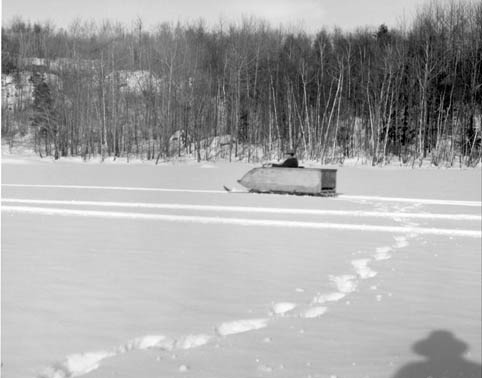
1958 prototype
A “miniature” snowmobile
Joseph-Armand’s ability to finally develop the light, individual vehicle he had always dreamed of was made possible by the advent of lighter motors, and especially by the revolutionary continuous track designed and patented by his son Germain at the Kingsbury experimental site.
At the end of 1958, working with close collaborators, Joseph-Armand creates the prototype for a “miniature” snowmobile. The April 1959 thaw meant the end of Joseph-Armand’s Valcourt trials and a chance to take the machine for a visit with his friend Maurice Ouimet, a Marie-Immaculée oblate and missionary among the Ojibwa peoples of Lansdowne House in Northern Ontario. Fascinated by the little vehicle, the natives try it almost non-stop for three days. Joseph-Armand is satisfied with the results, gives the vehicle to Father Ouimet as a gift, and returns to Valcourt to complete the project.
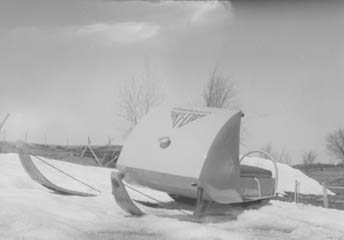
The first Ski-Doo® snowmobile model, marketed in 1959-1960
Production and marketing
Mass production of the Ski-Doo® snowmobile begins in the autumn of 1959. It is immediately welcomed by missionaries, trappers, prospectors, surveyors, and other people who need to travel over snow in isolated regions. But the little $900 machine also finds a keen new clientele in sports and outdoor recreation lovers, who eventually become the reason for the snowmobile’s immense popularity in the years to come.
After a modest start, demand increases from year to year as promotion and the sales network expand. In 1959-60, 225 units are produced; 250 in 1960-61, then 1200 in 1961-62, 2500 in 1962-63 and 8352 in 1963-64 requiring numerous expansions to the Valcourt facilities.
Always concerned with self-sufficiency, in 1963 Joseph-Armand Bombardier establishes his company’s second subsidiary, Roski Ltd., in Roxton Falls near Valcourt, for the manufacture of fibreglass parts required for the snowmobile hoods.
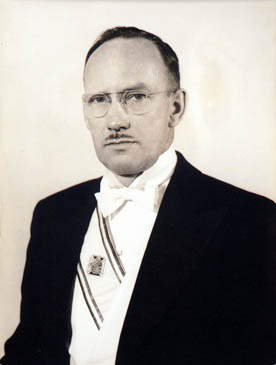
Joseph-Armand Bombardier, Knight of Colombus
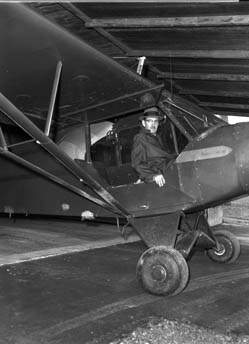
Joseph-Armand Bombardier and his plane
The dream is interrupted
Joseph-Armand Bombardier would only see the earliest signs of the phenomenal popularity of his snowmobile. His death on February 18, 1964 at the age of 56 ends a full and happy life. With his departure, the world loses an ingenious inventor and exceptional entrepreneur. In a moving letter to his children, he encourages them to pursue his work. The success of Bombardier Inc. and the humanitarian and social mission fulfilled by the J. Armand Bombardier Foundation show he had every reason to have confidence in them.
A model citizen
Success in no way diminishes Joseph-Armand Bombardier’s social responsibility and attachment to his hometown. He recruits his workforce in Valcourt and respects the pace of life in the region, such as by allowing farmers to work their fields in the summer and take factory shifts in the winter. He also demands the best of himself and his employees, increasing their pride and sense of belonging.
Joseph-Armand takes an active part in the community life of Valcourt. He serves as municipal councillor, founds council 3207 of the Valcourt Knights of Columbus, and earns the title Knight of Saint-Grégoire-le-Grand for his support of Church endeavours.
Passionate about music, he is a member of the parish choir, and enjoys many happy moments singing with his children whom he accompanies on the piano. His love of music leads him to promote and finance the launch of an harmony in Valcourt, and his concern for education leads him to help and encourage youth to pursue their studies.
Despite his need for solitude to dream, cogitate, design, invent, develop, and test, Joseph-Armand Bombardier always welcomes family, friends, employees, and fellow citizens who need a sympathetic ear, a helping hand, support, or advice.
Hunting and fishing are his ways of enjoying the natural world, which he loves and visits often while testing vehicles. He also enjoys flying, and buys a plane and learns to pilot it maybe even dreaming of one day exploring air transport.
Genealogy
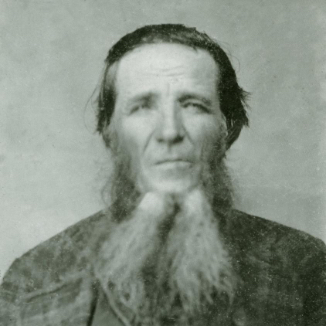
Léon Bombardier
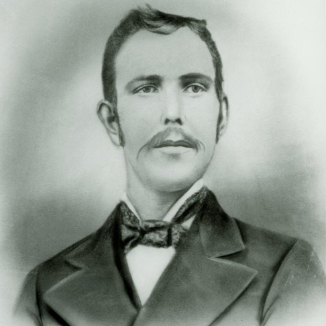
Octave Bombardier
The first Bombardier to settle in New France was named André. Born in Lille, France, in 1679, he arrived in this country around 1700 as a soldier of the d’Aloigny Company. Because of his very active military career, he earned the nickname “Passe Partout” (meaning he let nothing stand in his way). He took part in founding the city of Detroit in the United States, where he lived with his wife Marie Demers, whom he had married in Montreal on June 12, 1706. Their first two sons were born in Detroit. André returned to New France with his whole family in the fall of 1711, settling permanently in Pointe-aux-Trembles.
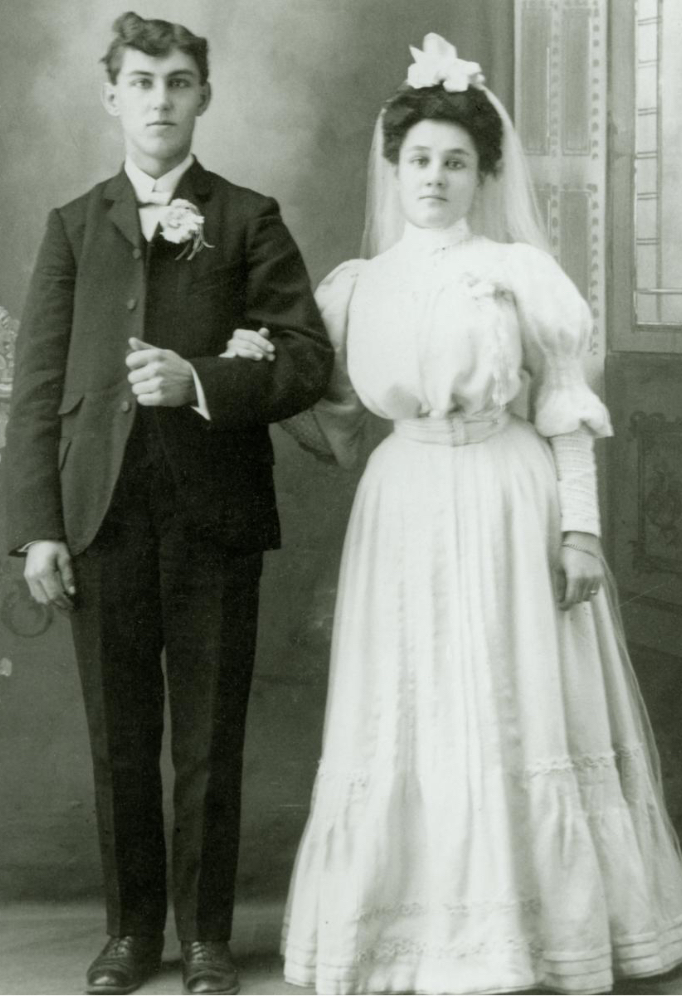
Wedding of Alfred Bombardier and Anna Gravel
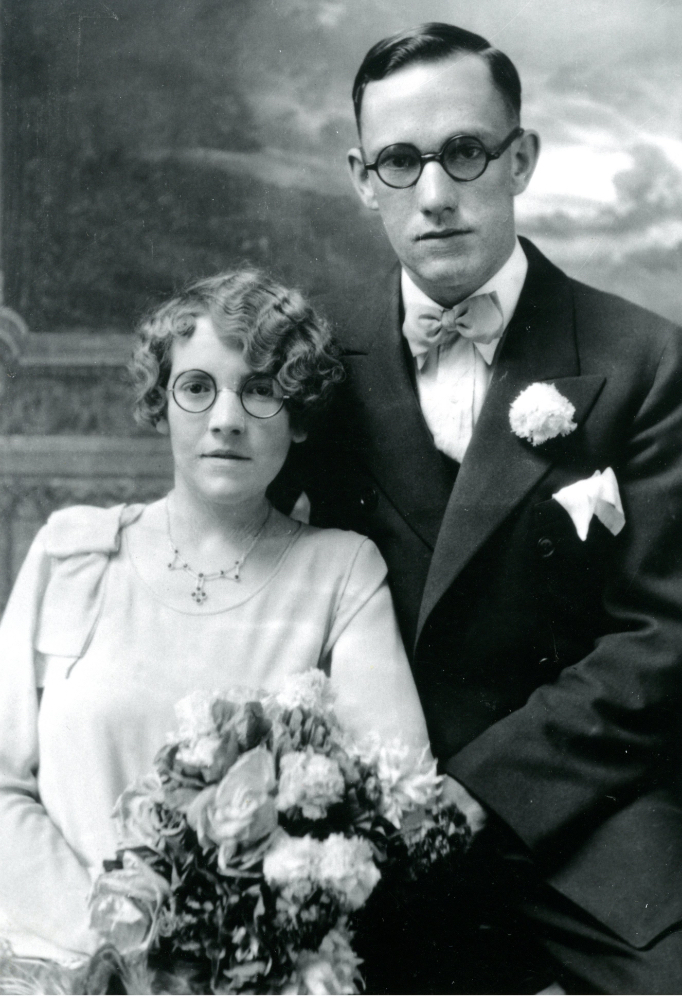
Wedding of Joseph-Armand Bombardier and Yvonne Labrecque
Below is the Bombardier genealogy – father to son – from the first in Canada until Joseph-Armand Bombardier, according to their wedding date.

Joseph-Armand Bombardier has received countless posthumous testimonies of respect, admiration, and recognition from various associations, institutions or organizations wishing to pay tribute to the ingenuity of the man and his work.
Patents
Below is the patent list acquired by J. Armand Bombardier. The titles are written as they appear on the patents.
- Auto-chenilles pour la neige - No. 367104
-
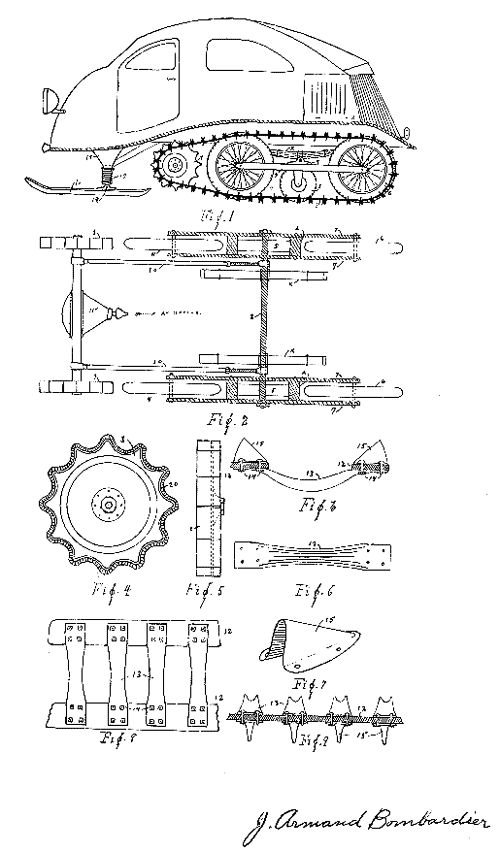
Patent date: 1937/06/29
Date of demand: 1936/12/21
Patent title: auto-chenilles pour la neige
Patent number: 367104
Origin: Canada
- Véhicule à chenille - No 405584
-
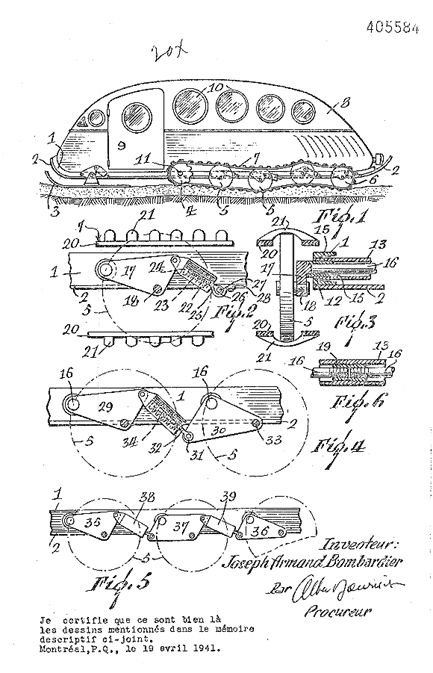
Patent date: 1942/06/23
Date of demand: 1941/04/24
Patent title: véhicule à chenille
Patent number: 405584
Origin: Canada
- Véhicule à chenille - No 410471
-
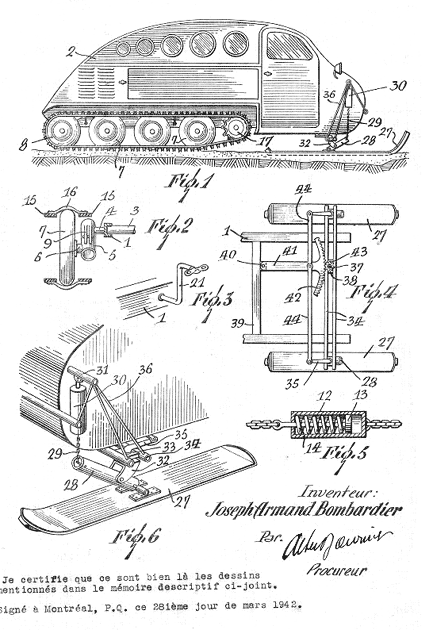
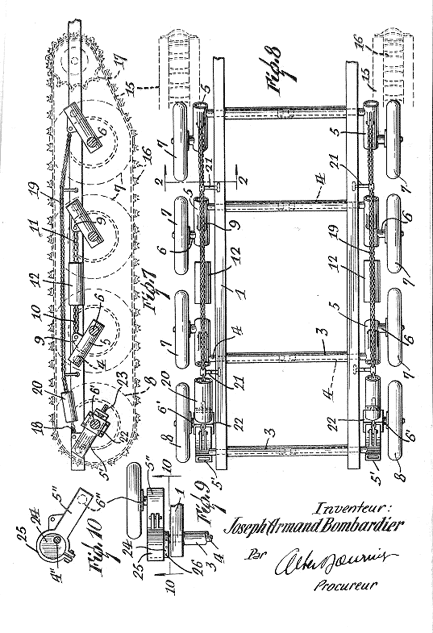
Patent date: 1943/02/09
Date of demand : 1942/03/30
Patent title : véhicule à chenille
Patent number : 410471
Origin : Canada
- Chain tread - No 2346351
-
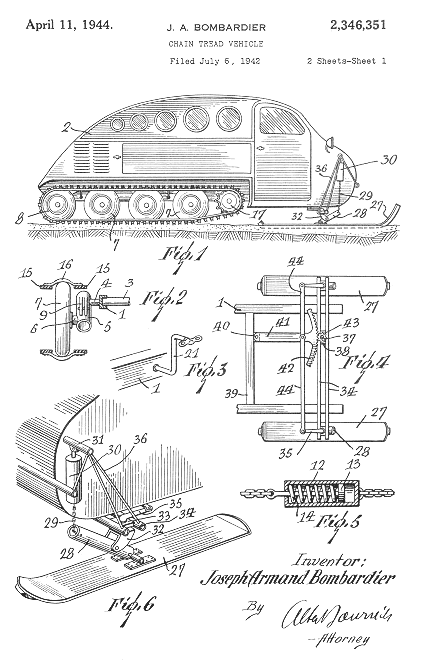
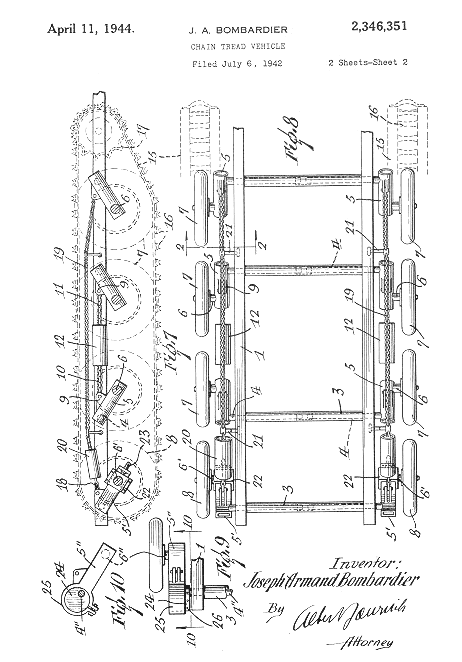
Patent date: 1944/04/11
Date of demand : 1942/07/06
Patent title : chain tread
Patent number : 2346351
Origin : États-Unis
- Ski suspensions - No 419642
-
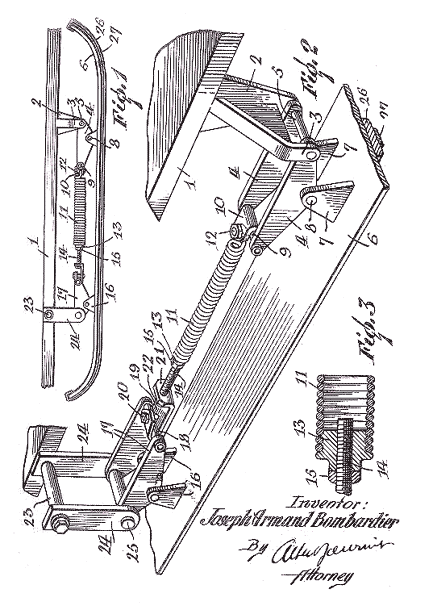
Patent date : 1944/04/18
Date of demand : 1943/07/03
Patent title : ski suspensions
Patent number : 419642
Origin : Canada
- Ski suspensions - No 2343526
-
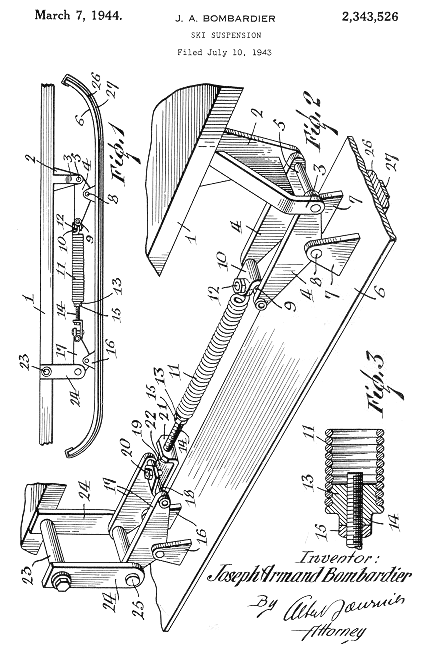
Patent date: 1944/03/07
Date of demand: 1943/07/10
Patent title: ski suspensions
Patent number: 2343526
Origin: États-Unis
- Wheel mountings - No 421051
-
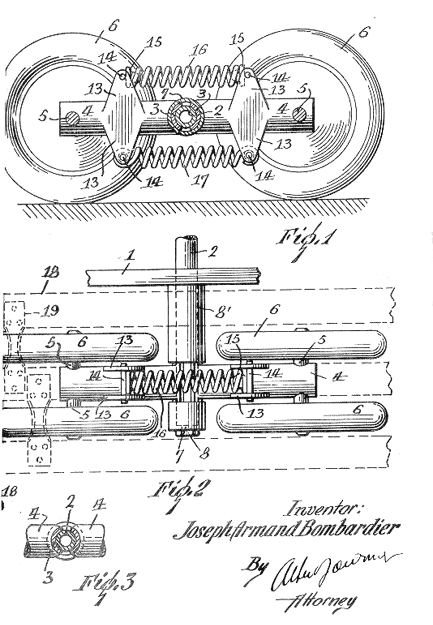
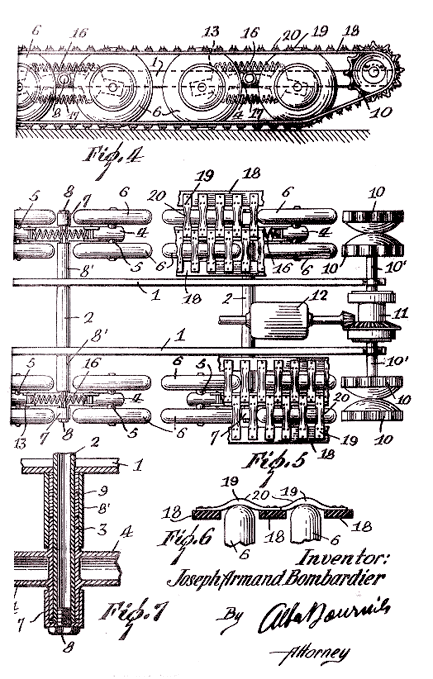
Patent date: 1944/06/27
Date of demand: 1942/10/07
Patent title: wheel mountings
Patent number: 421051
Origin: Canada
- Wheel mountings - No 2367751
-
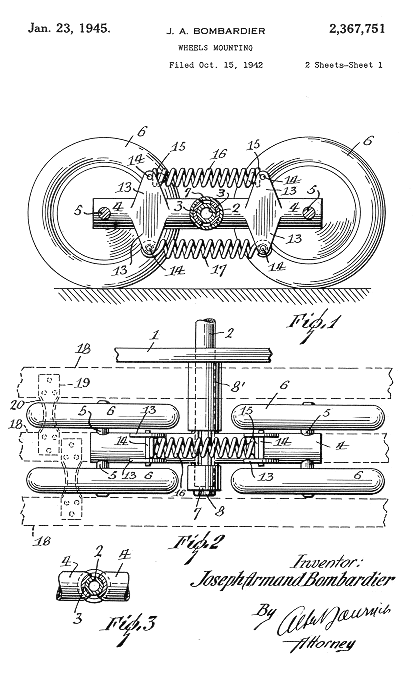
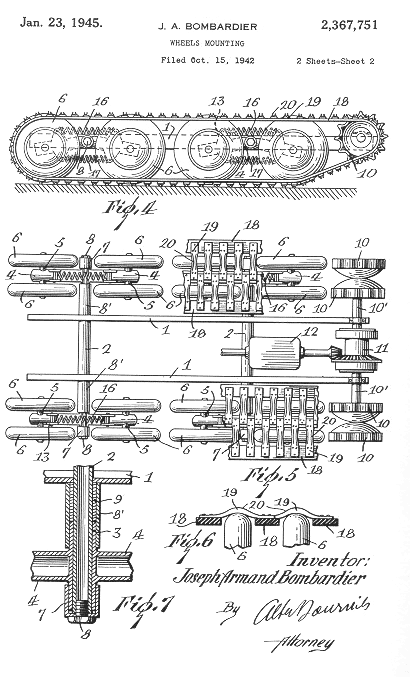
Patent date: 1945/01/23
Date of demand: 1942/10/15
Patent title: wheel mountings
Patent number: 2367751
Origin: États-Unis
- Traction devices - No 422405
-
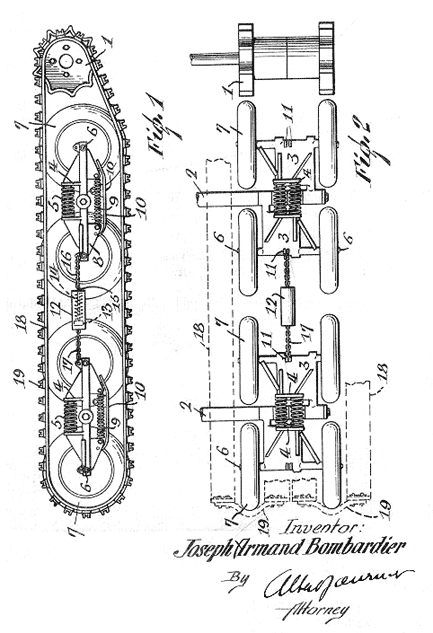
Patent date: 1944/09/05
Date of demand: 1943/07/03
Patent title: traction devices
Patent number: 422405
Origin: Canada
- Traction devices - No 2355266
-
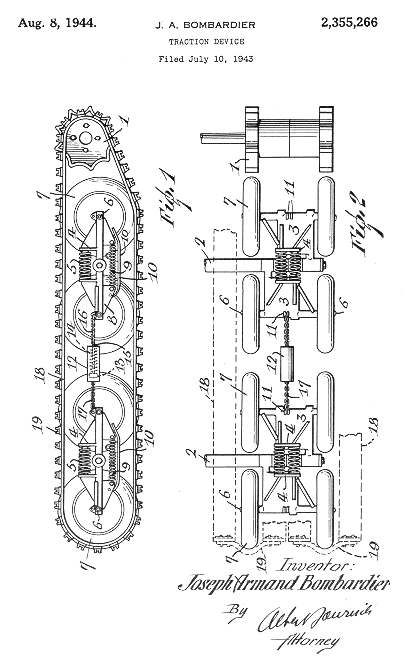
Patent date: 1944/08/08
Date of demand: 1943/07/10
Patent title: traction devices
Patent number: 2355266
Origin: États-Unis
- Vehicle spring suspensions - No 422404
-
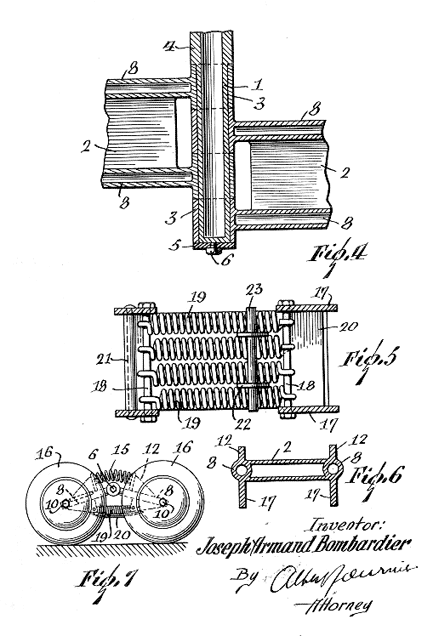
Patent date: 1944/09/05
Date of demand: 1943/07/03
Patent title: vehicle spring suspensions
Patent number: 422404
Origin: Canada
- Vehicle spring suspensions - No 2367456
-
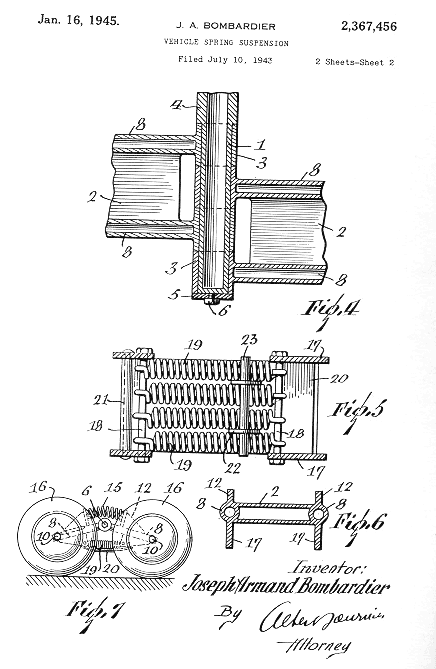
Patent date: 1945/01/16
Date of demand: 1943/07/10
Patent title: vehicle spring suspensions
Patent number: 2367456
Origin: États-Unis
- Sprocket wheels - No 428317
-
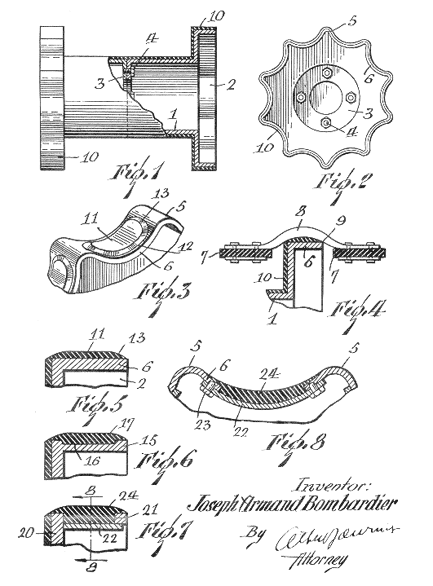
Patent date: 1945/06/26
Date of demand: 1943/07/03
Patent title: sprocket wheels
Patent number: 428317
Origin: Canada
- Sprocket wheels - No 2374644
-
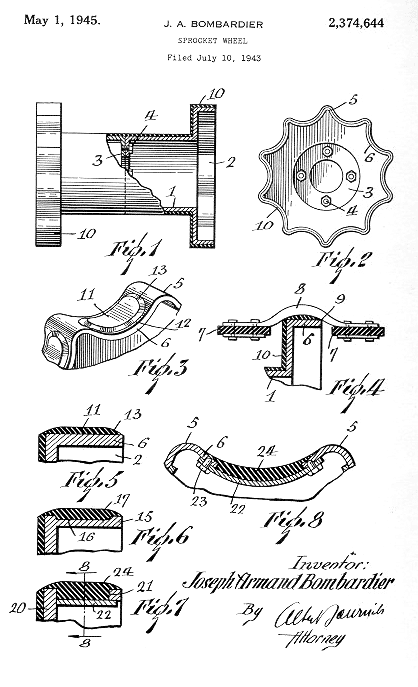
Patent date: 1945/05/01
Date of demand: 1943/07/10
Patent title: sprocket wheels
Patent number: 2374644
Origin: États-Unis
- Vehicle track - No 437969
-
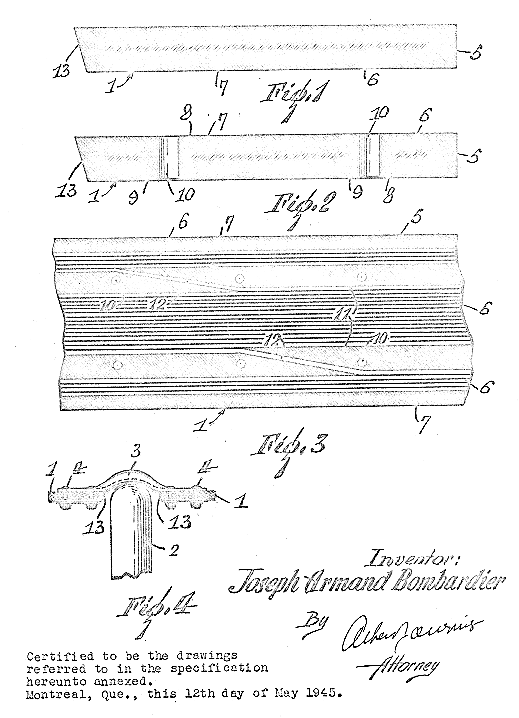
Patent date: 1946/11/19
Date of demand: 1945/05/14
Patent title: vehicle track
Patent number: 437969
Origin: Canada
- Snow removing apparatus - No 440193
-
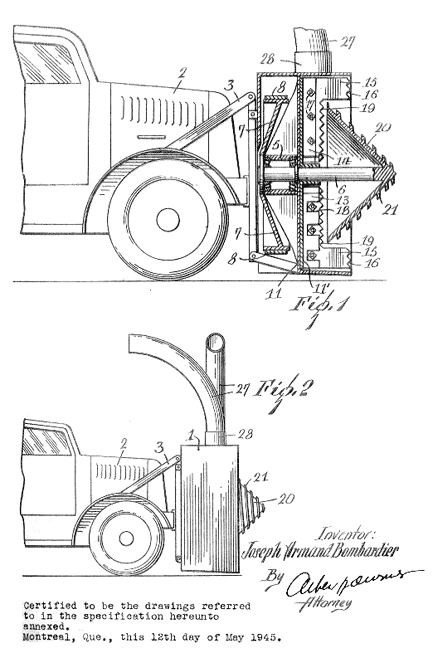
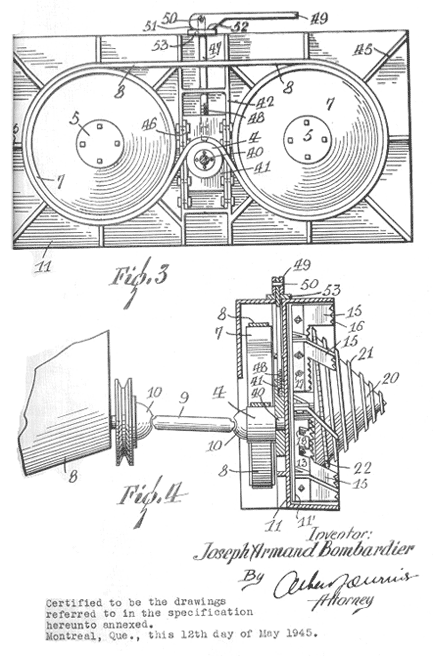
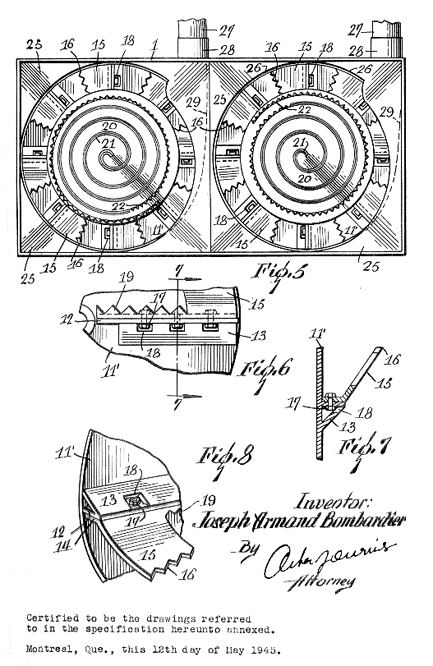
Patent date: 1947/03/18
Date of demand: 1945/05/14
Patent title: snow removing apparatus
Patent number: 440193
Origin: Canada
- Improvements in endless track vehicles - No 679896
-
Patent date: 1952/09/24
Date of demand: 1950/11/01
Patent title: improvements in endless track vehicles
Patent number: 679896
Origin: Royaume-Uni
- Endless track for vehicles - No 687438
-
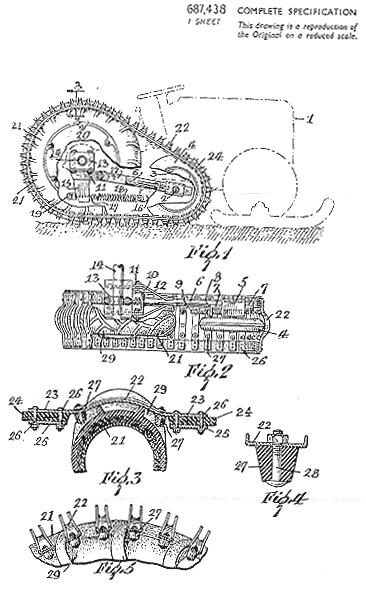
Patent date: 1953/02/11
Date of demand: 1950/11/01
Patent title: endless track for vehicles
Patent number: 687438
Origin: Royaume-Uni
- Improvement in endless tracked tractors - No 773972
-
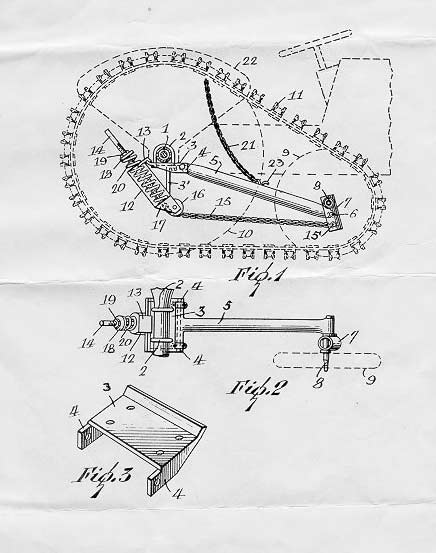
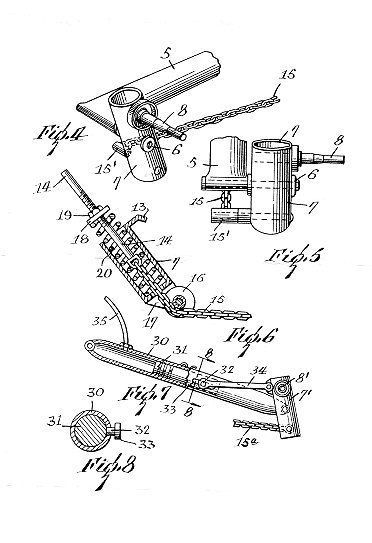
Patent date: 1957/05/01
Date of demand: 1952/11/19
Patent title: Improvement in endless tracked tractors
Patent number: 773972
Origin: Royaume-Uni
- Traction devices - No 478066
-
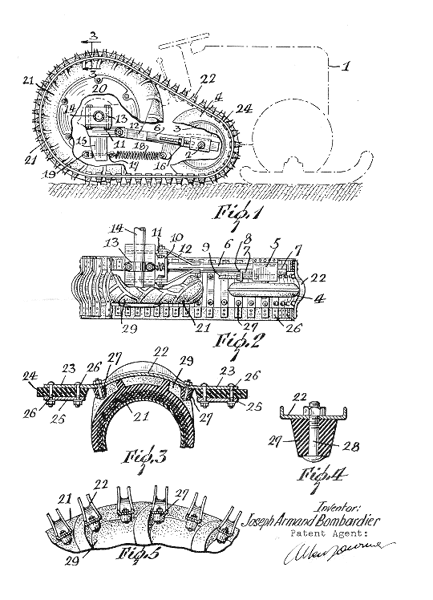
Patent date: 1951/10/30
Date of demand: –
Patent title: traction devices
Patent number: 478066
Origin: Canada
- Tractor unit - No 486645
-

Patent date: 1952/09/23
Date of demand: –
Patent title: tractor unit
Patent number: 486645
Origin: Canada
- Tractor unit - No 2587813
-
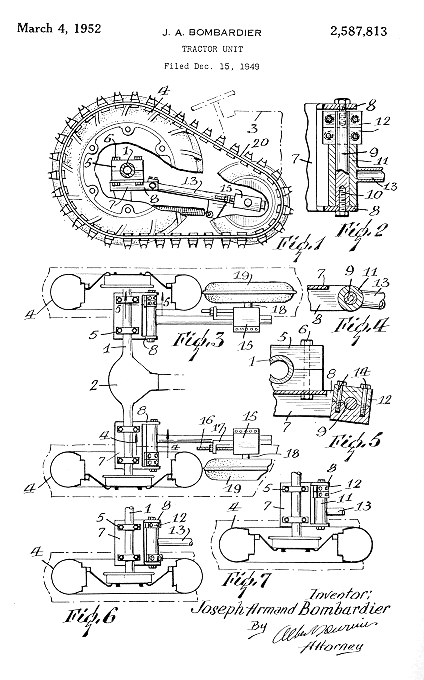
Patent date: 1952/03/04
Date of demand: 1949/12/15
Patent title: tractor unit
Patent number: 2587813
Origin: États-Unis
- Auxiliary axle assembly for tractors - No 483846
-
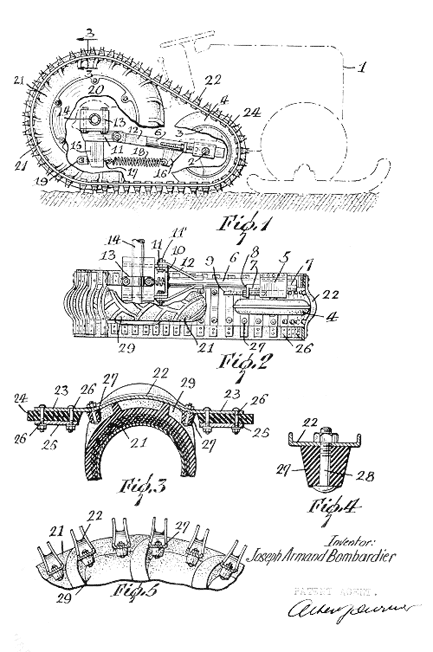
Patent date: 1952/06/10
Date of demand: 1949/04/06
Patent title: auxiliary axle assembly for tractors
Patent number: 483846
Origin: Canada
- Tensioning device for tractors - No 501968
-
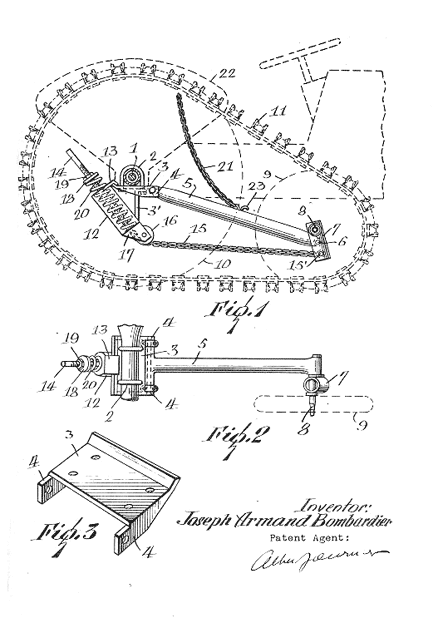
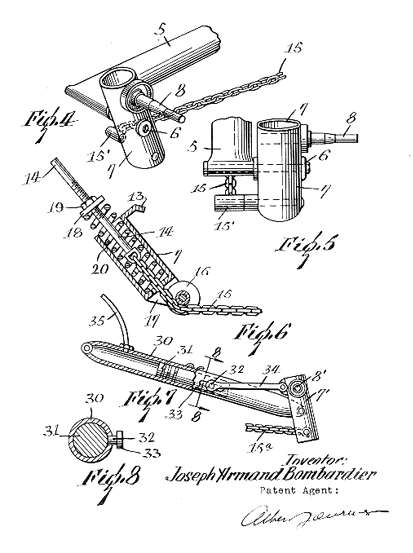
Patent date: 1954/05/04
Date of demand: –
Patent title: tensioning device for tractors
Patent number: 501968
Origin: Canada
- Tensioning device for tractors - No 2654639
-
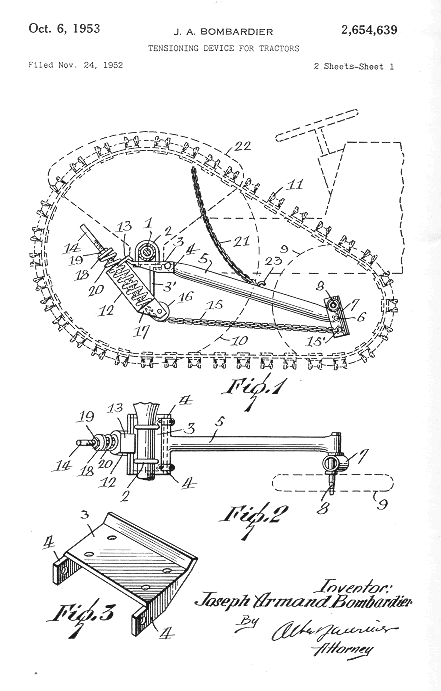
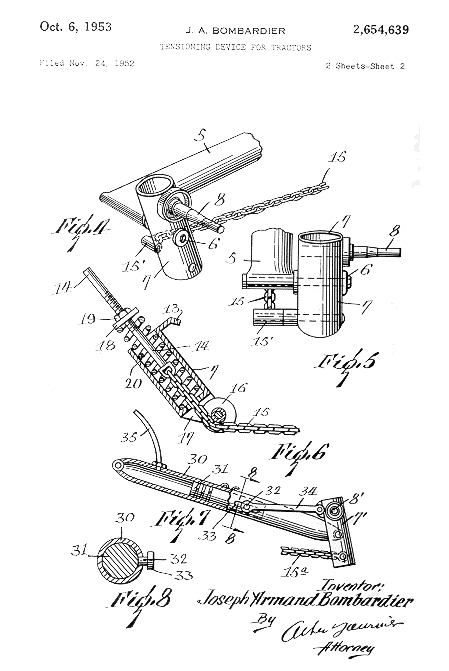
Patent date: 1953/10/06
Date of demand: 1952/11/24
Patent title: tensioning device for tractors
Patent number: 2654639
Origin: États-Unis
- Vulcanizing apparatus - No 527713
-
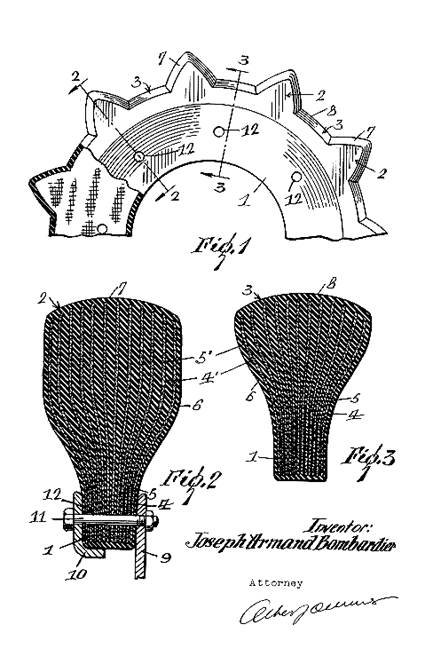
Patent date: 1956/07/17
Date of demand: 1953/05/16
Patent title: vulcanizing apparatus
Patent number: 527713
Origin: Canada
- Vulcanizing apparatus - No 2659101
-
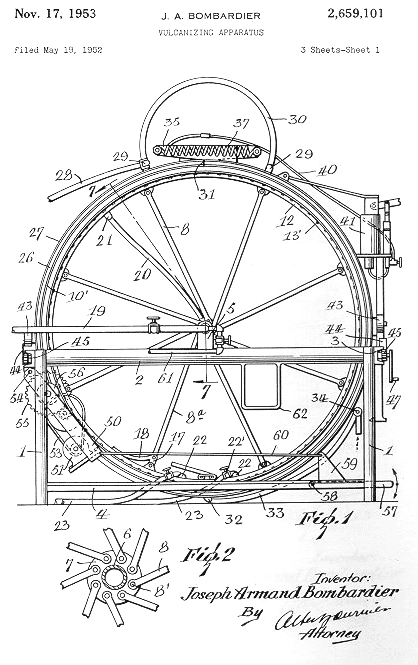
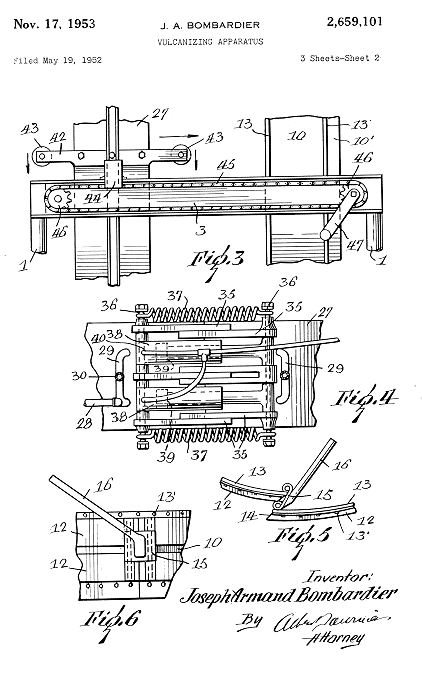
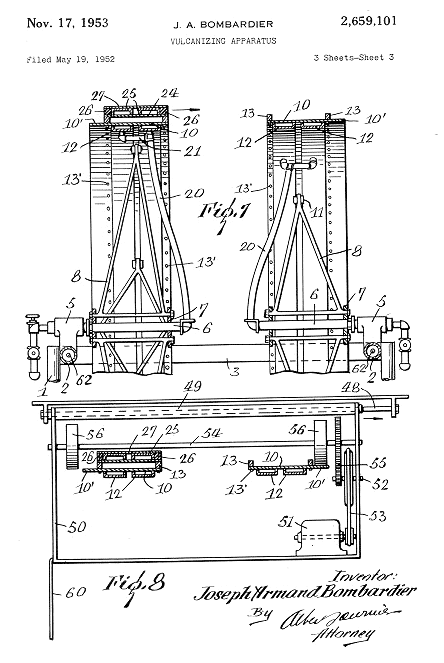
Patent date: 1953/11/17
Date of demand: 1952/05/19
Patent title: vulcanizing apparatus
Patent number: 2659101
Origin: États-Unis
- Sprocket wheel - No 521164
-
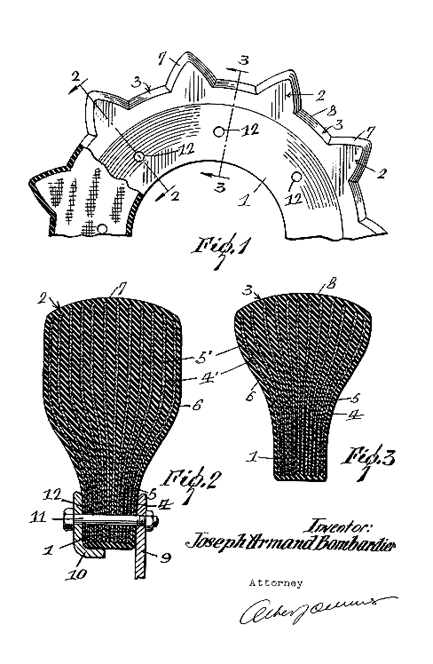
Patent date: 1956/01/31
Date of demand: –
Patent title: sprocket wheel
Patent number: 521164
Origin: Canada
- Sprocket wheel - No 2721485
-
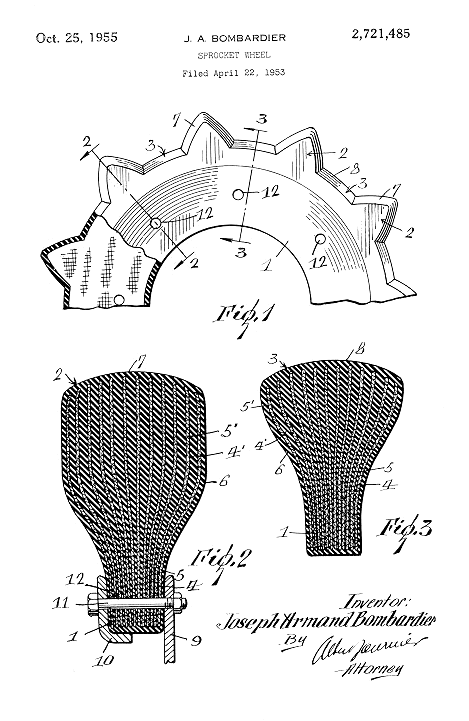
Patent date: 1955/10/25
Date of demand: 1953/04/22
Patent title: sprocket wheel
Patent number: 2721485
Origin: États-Unis
- Autoneige miniature - No 602601
-
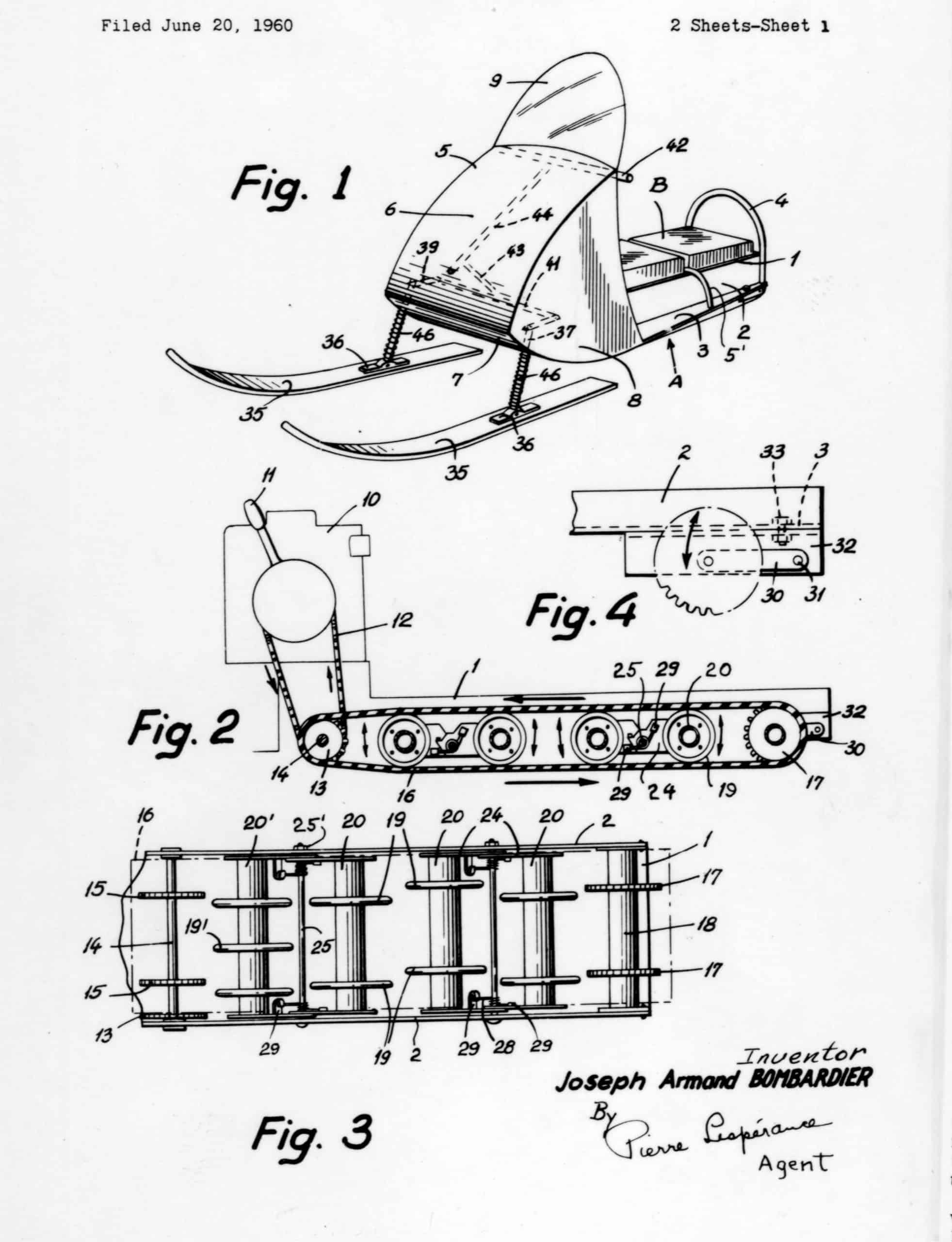

Patent date: 1960/08/02
Date of demand: –
Patent title: autoneige miniature
Patent number: 602601
Origin: Canada
- Endless track vehicle - No 3023824
-
Patent date: 1962/03/06
Date of demand: 1960/06/20
Patent title: endless track vehicle
Patent number: 3023824
Origin: États-Unis
- Méchanisme de retenu d'arbre sur véhicule - No 617529
-
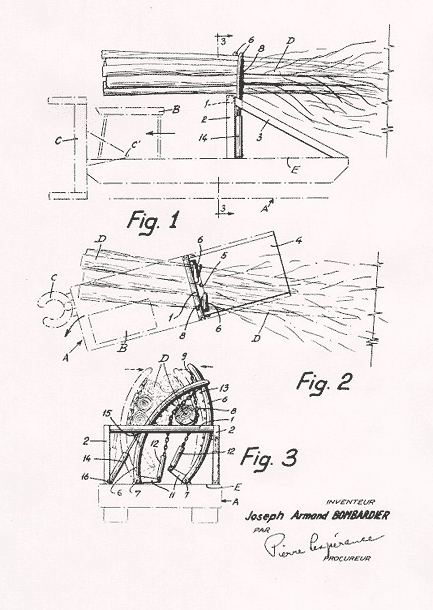
Patent date: 1961/04/04
Date of demand: 1959/12/12
Patent title: méchanisme de retenu d’arbre sur véhicule
Patent number: 617529
Origin: Canada
- Tree holding means for motor vehicule - No 3008731
-
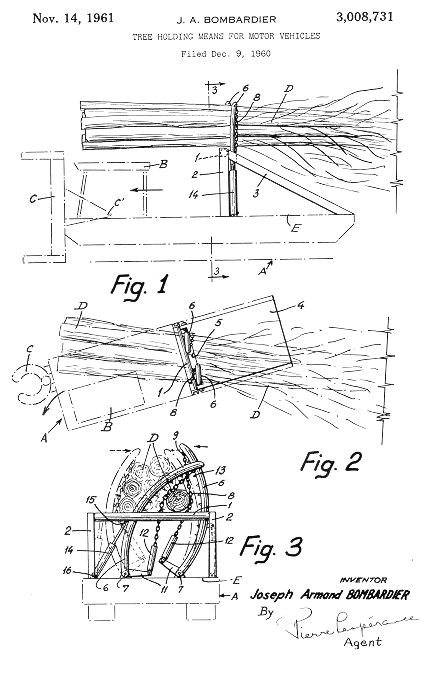
Patent date: 1961/11/14
Date of demand: 1960/12/09
Patent title: tree holding means for motor vehicule
Patent number: 3008731
Origin: États-Unis
- Mâchoires pour appareil à ébrancher les arbres - No 620519
-
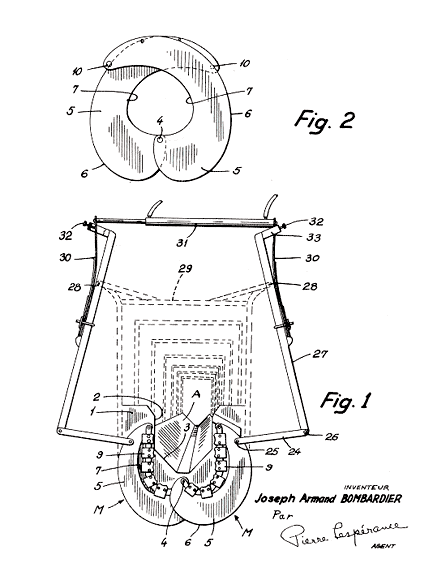
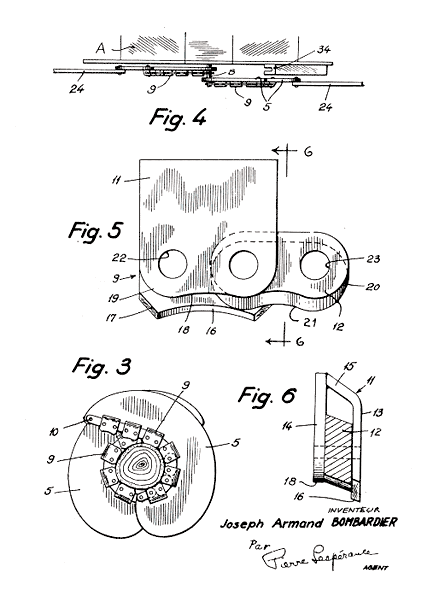
Patent date: 1961/05/23
Date of demand: 1959/06/13
Patent title: mâchoires pour appareil à ébrancher les arbres
Patent number: 620519
Origin: Canada
- Tree delimbing jaws - No 2989097
-
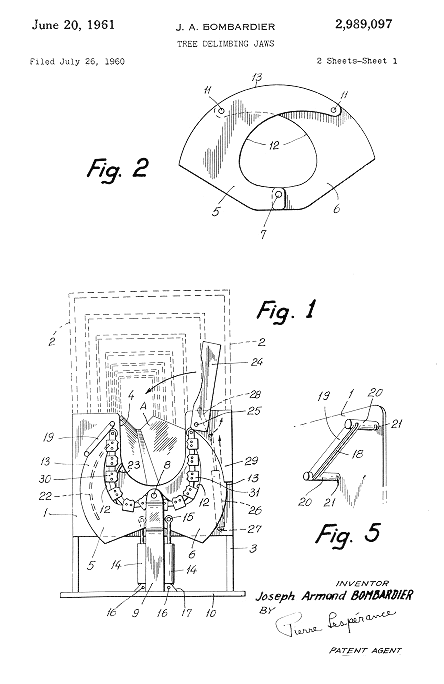
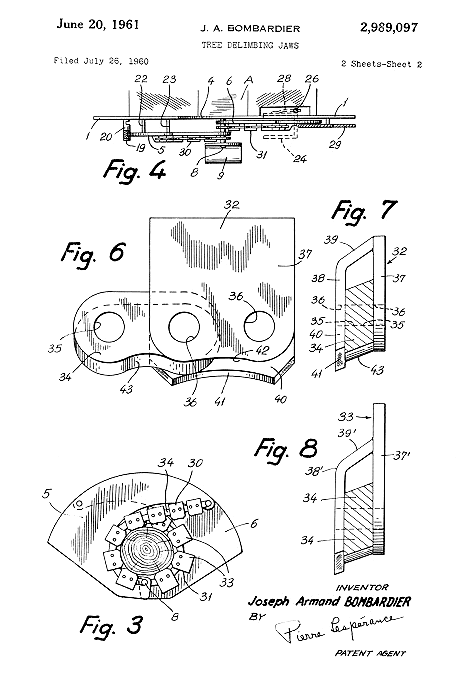
Patent date: 1961/06/20
Date of demand: 1960/07/26
Patent title: tree delimbing jaws
Patent number: 2989097
Origin: États-Unis
- Machine pour couper, charger et transporter les arbres - No 621783
-
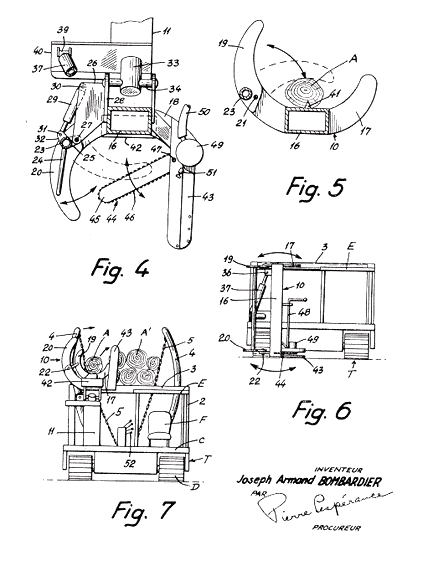
Patent date: 1961/06/13
Date of demand: 1959/12/15
Patent title: machine pour couper, charger et transporter les arbres
Patent number: 621783
Origin: Canada
- Motor vehicle for cutting, loading and transporting trees - No 3074447
-
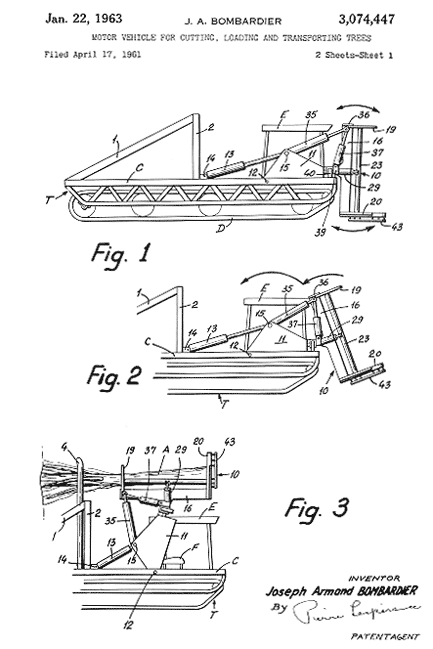
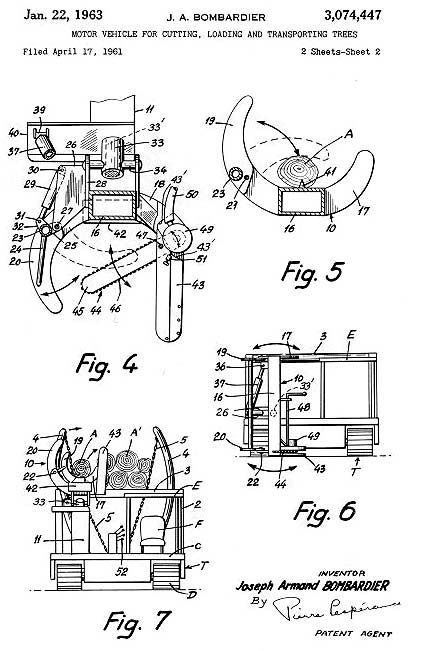
Patent date: 1963/01/22
Date of demand: 1961/04/17
Patent title: motor vehicle for cutting, loading and transporting trees
Patent number: 3074447
Origin: États-Unis
- Machine à ébrancher et couper les arbres en billots - No 645245
-
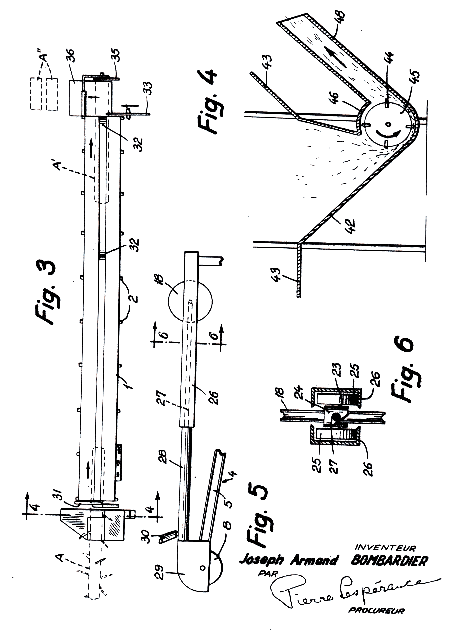
Patent date: 1962/07/24
Date of demand: 1959/06/18
Patent title: machine à ébrancher et couper les arbres en billots
Patent number: 645245
Origin: Canada
- Machine for delimbing and cutting trees into logs - No 3029848
-
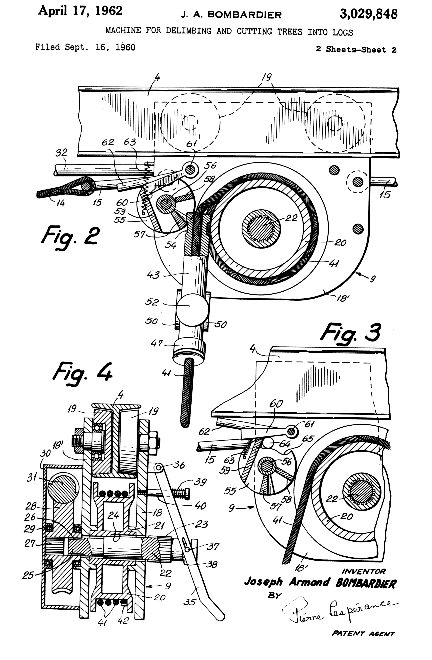
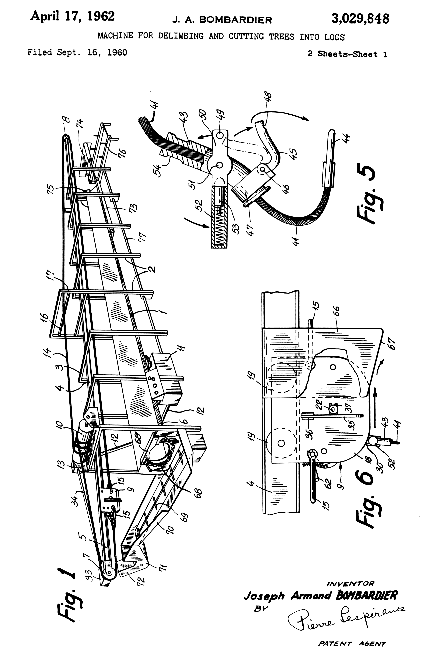
Patent date: 1962/04/17
Date of demand: 1960/09/16
Patent title: machine for delimbing and cutting trees into logs
Patent number: 3029848
Origin: États-Unis
- Embrayage automatique et transmission à vitesse variable - No 724395
-

Patent date: 1965/12/28
Date of demand: 1962/06/29
Patent title: embrayage automatique et transmission à vitesse variable
Patent number: 724395
Origin: Canada
- Système de déneigement de chenilles - No 720023
-
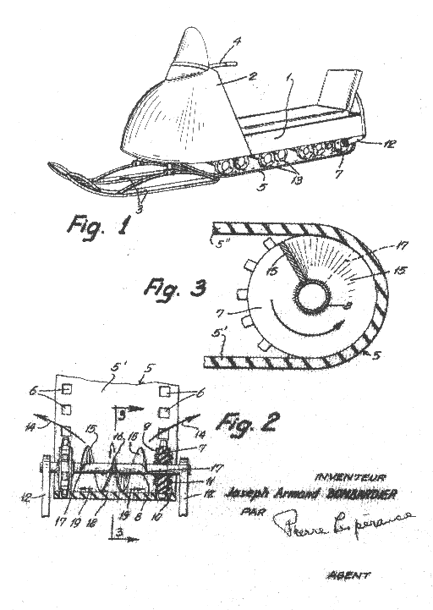
Patent date: 1965/10/19
Date of demand: –
Patent title: système de déneigement de chenilles
Patent number: 720023
Origin: Canada
- Snow-expelling system for endless track vehicle - No 3236568
-
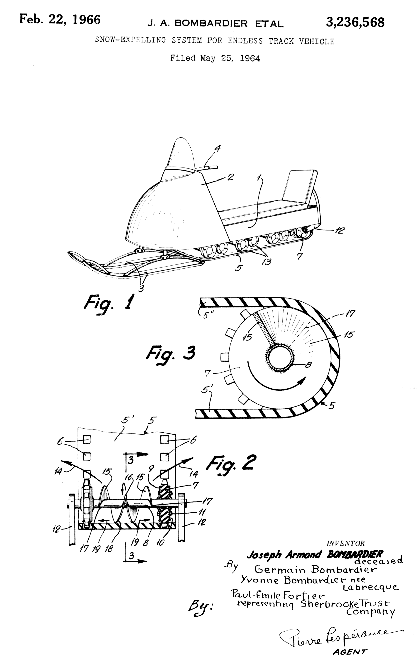
Patent date: 1966/02/22
Date of demand: 1964/05/25
Patent title: snow-expelling system for endless track vehicle
Patent number: 3236568
Origin: États-Unis
- Embrayage automatique et transmission à vitesse variable - No 788190
-
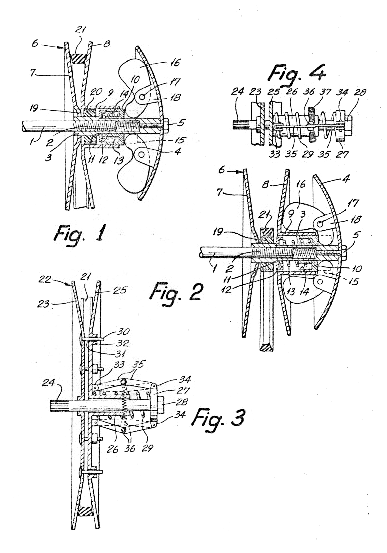
Patent date: 1968/06/25
Date of demand: 1965/10/02
Patent title: embrayage automatique et transmission à vitesse variable
Patent number: 788190
Origin: Canada

